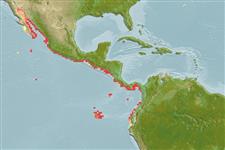Klassifizierung / Names
Namen | Synonyme | Catalog of Fishes(Gattung, Arten) | ITIS | CoL | WoRMS | Cloffa
Environment: milieu / climate zone / depth range / distribution range
Ökologie
seewasser riff-verbunden; tiefenbereich 1 - 37 m (Ref. 27020). Tropical
Eastern Central Pacific: Gulf of California to Gorgona Island, Colombia.
Size / Gewicht / Alter
Maturity: Lm ? range ? - ? cm
Max length : 9.0 cm TL Männchen/unbestimmt; (Ref. 59088)
Rückenflossenstacheln (insgesamt): 7 - 8; Rückenflossenweichstrahlen (insgesamt): 19-24; Afterflossenstacheln 3; Afterflossenweichstrahlen: 17 - 20; Wirbelzahl: 26. Live fish with light yellowish brown body, the center of each scale with dark brown spot thus forming a longitudinal pattern of dark brown lines. Prominent black spot on opercle. A broad-based, long, slender, dermal flap dorsally on eye. Two large pores in mid-interorbital space, one on each side close to the edge of the orbit, with the aperture nearly covered by a flap from the median side. There are several small pores in the median part of interorbital. Tubular anterior nostril when laid back reaching at most half way to posterior nostril (Ref. 27020).
Inhabits rocky crevices. Feeds mainly on small fishes and benthic crustaceans (Ref. 11482).
Life cycle and mating behavior
Geschlechtsreife | Fortpflanzung | Ablaichen | Eier | Fecundity | Larven
Allen, G.R. and D.R. Robertson, 1994. Fishes of the tropical eastern Pacific. University of Hawaii Press, Honolulu. 332 p. (Ref. 11482)
IUCN Rote Liste Status (Ref. 130435)
Bedrohung für Menschen
Harmless
Nutzung durch Menschen
Mehr Information
NamenSynonymeMetabolismusRäuberÖkotoxikologieFortpflanzungGeschlechtsreifeAblaichenSpawning aggregationFecundityEierEientwicklung
ReferenzenAquakulturAquakultur ProfilZuchtlinienGenetikElectrophoresesVererbbarkeitKrankheitenVerarbeitungNutrientsMass conversion
PartnerBilderStamps, Coins Misc.LauteCiguateraGeschwindigkeitSchwimmstilKiemenoberflächeOtolithsGehirngrößeSehfähigkeit
Tools
Zusatzinformationen
Download XML
Internet Quellen
Estimates based on models
Preferred temperature (Ref.
123201): 23.4 - 28.5, mean 26.9 °C (based on 28 cells).
Phylogenetic diversity index (Ref.
82804): PD
50 = 0.5001 [Uniqueness, from 0.5 = low to 2.0 = high].
Bayesian length-weight: a=0.01148 (0.00451 - 0.02922), b=3.06 (2.84 - 3.28), in cm total length, based on LWR estimates for this (Sub)family-body shape (Ref.
93245).
Trophic level (Ref.
69278): 3.9 ±0.64 se; based on food items.
Fishing Vulnerability (Ref.
59153): Low vulnerability (10 of 100).
Nutrients (Ref.
124155): Calcium = 122 [62, 248] mg/100g; Iron = 0.858 [0.435, 1.542] mg/100g; Protein = 18.4 [16.5, 20.2] %; Omega3 = 0.191 [0.112, 0.329] g/100g; Selenium = 25.1 [12.6, 49.4] μg/100g; VitaminA = 153 [47, 517] μg/100g; Zinc = 1.76 [1.14, 2.62] mg/100g (wet weight);
